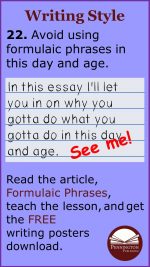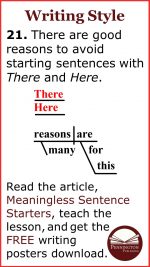Vague Pronoun References
“They didn’t take the donuts,” Rhett told his teacher.
“To whom are you referring? the teacher asked.
“Those kids who make us get into trouble with their friends like they do all the time. You should punish them.”
“That’s horrible,” the teacher responded. “But it’s hard to punish vague pronoun references.”
Definition and Examples
A vague pronoun does not clearly identify its antecedent. An antecedent is the noun or pronoun that the pronoun refers to or re-names. Vague pronouns usually consist of four types:
- More than one antecedent could match the pronoun. Revise by repeating the noun. Example: Dishes were on the tables, but we didn’t need them. Dishes were on the tables, but we didn’t need the dishes.
- Demonstrative pronouns (this, that, these, or those) are used on their own. Revise by adding a noun following the pronoun. Example: That is beautiful. That painting is beautiful.
- The antecedent is an adjective. Revise by changing the pronoun reference from an adjective to a noun. Example: I called Jesse’s work Jesse at his work, but he never answered.
- The pronoun has no antecedent. Revise by adding the antecedent. Example: Although he was extremely rich, he didn’t spend it. Although he had money, he didn’t spend it.
Read the rule.
Pronouns must clearly identify their antecedents. Keep pronoun references close to their antecedents to avoid confusion.
Re-write these sentences and [bracket] the vague pronouns and antecedents.
- I love art galleries, especially paintings. These seems to be from the Italian artists.
- The books were already on the students’ desks, but we didn’t need them.
- I asked to speak to Maribel’s father, but she would not talk to me.
- Please get your paper out of your backpack and pass it forward.
- His math teachers taught him, but he didn’t use it in his job.
Revise the vague pronoun to clearly identify its antecedent.
Keep pronoun references close to subjects in long sentences to make them clear.
Answers
- I love art [galleries], especially paintings. [These] seems to be from the Italian artists.
- The [books] were already on the students’ [desks], but we didn’t need [them].
- I asked to speak to [Maribel’s father], but [she] would not talk to me.
- Please get your [paper] out of your [backpack] and pass [it] forward.
- His [math teachers] taught him, but he didn’t use [it] in his job.
*****

Pennington Publishing Grammar Programs
Teaching Grammar, Usage, and Mechanics (Grades 4, 5, 6, 7, 8, and High School) are full-year, traditional, grade-level grammar, usage, and mechanics programs with plenty of remedial practice to help students catch up while they keep up with grade-level standards. Twice-per-week, 30-minute, no prep lessons in print or interactive Google slides with a fun secret agent theme. Simple sentence diagrams, mentor texts, video lessons, sentence dictations. Plenty of practice in the writing context. Includes biweekly tests and a final exam.
Grammar, Usage, and Mechanics Interactive Notebook (Grades 4‒8) is a full-year, no prep interactive notebook without all the mess. Twice-per-week, 30-minute, no prep grammar, usage, and mechanics lessons, formatted in Cornell Notes with cartoon response, writing application, 3D graphic organizers (easy cut and paste foldables), and great resource links. No need to create a teacher INB for student make-up work—it’s done for you! Plus, get remedial worksheets, biweekly tests, and a final exam.
Syntax in Reading and Writing is a function-based, sentence-level syntax program, designed to build reading comprehension and increase writing sophistication. The 18 parts of speech, phrases, and clauses lessons are each leveled from basic (elementary) to advanced (middle and high school) and feature 5 lesson components (10–15 minutes each): 1. Learn It! 2. Identify It! 3. Explain It! (analysis of challenging sentences) 4. Revise It! (kernel sentences, sentence expansion, syntactic manipulation) 5. Create It! (Short writing application with the syntactic focus in different genre).
Get the Diagnostic Grammar, Usage, and Mechanics Assessments, Matrix, and Final Exam FREE Resource:
![]()







